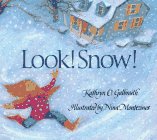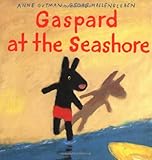Lesson 2: When (Seasons, Day, or Night)
Lesson Plan
Look! Snow!

- Learning Goal
- Identify when a story takes place.
- Duration
- Approximately 50 minutes
- Necessary Materials
- Provided: Independent Practice Worksheet
Not Provided: Look! Snow! by Kathryn O. Galbraith and Gaspard at the Seashore by Anne Gutman
-
Teacher Modeling

will review how to determine where a story takes place. I will explain that another part of the setting is when a story takes place. I will model using pictures and information in the text (up to page 10) to determine the season of Look! Snow! by Kathryn O. Galbraith. Because the characters in the book are wearing sweaters, hats, and warm clothes, it must be cold outside. I see that it is snowing. It only snows in the winter. This story must take place in winter. That is when it takes place.
TIP: You may need to provide vocabulary support for some students. Examples include the names of the seasons and alternative times of day such as evening, noon, midnight, etc.
-
Think Check
Ask: "How did I know that the story takes place in winter?" Students should respond that you looked at the pictures and read the text to give you clues to when the story takes place.
-
Guided Practice

will use pictures and text to determine if the story takes place during the day or night. We will discuss what evidence from the book (pictures: wearing pajamas; text: announcement of school closings; these things happen in the morning) helps us determine the time of day for the remainder of the book.
-
Independent Practice

will identify the season and time of day of the familiar book, Gaspard at the Seashore. You will explain orally or in writing how you determined this. (Independent Practice Worksheet is provided.)
Texts & Materials
Standards Alignment
(To see all of the ReadWorks lessons aligned to your standards, click here.)



I like the way the lesson contects to real life when building background. This is information students can use and connect to other situations, literature and subjects.
This is very helpful